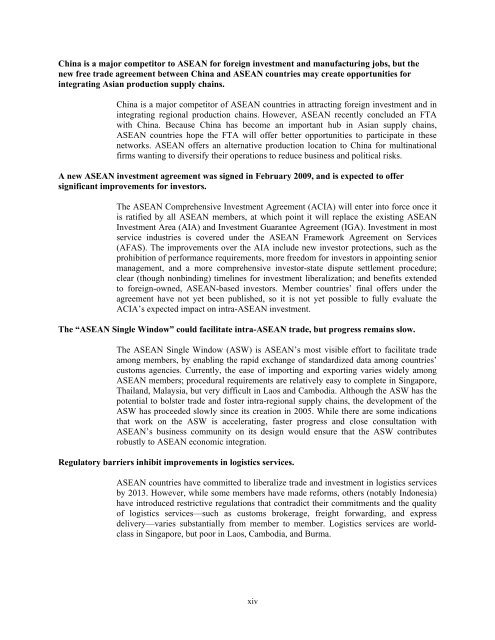ASEAN: Regional Trends in Economic Integration, Export ... - USITC
ASEAN: Regional Trends in Economic Integration, Export ... - USITC
ASEAN: Regional Trends in Economic Integration, Export ... - USITC
You also want an ePaper? Increase the reach of your titles
YUMPU automatically turns print PDFs into web optimized ePapers that Google loves.
Ch<strong>in</strong>a is a major competitor to <strong>ASEAN</strong> for foreign <strong>in</strong>vestment and manufactur<strong>in</strong>g jobs, but the<br />
new free trade agreement between Ch<strong>in</strong>a and <strong>ASEAN</strong> countries may create opportunities for<br />
<strong>in</strong>tegrat<strong>in</strong>g Asian production supply cha<strong>in</strong>s.<br />
Ch<strong>in</strong>a is a major competitor of <strong>ASEAN</strong> countries <strong>in</strong> attract<strong>in</strong>g foreign <strong>in</strong>vestment and <strong>in</strong><br />
<strong>in</strong>tegrat<strong>in</strong>g regional production cha<strong>in</strong>s. However, <strong>ASEAN</strong> recently concluded an FTA<br />
with Ch<strong>in</strong>a. Because Ch<strong>in</strong>a has become an important hub <strong>in</strong> Asian supply cha<strong>in</strong>s,<br />
<strong>ASEAN</strong> countries hope the FTA will offer better opportunities to participate <strong>in</strong> these<br />
networks. <strong>ASEAN</strong> offers an alternative production location to Ch<strong>in</strong>a for mult<strong>in</strong>ational<br />
firms want<strong>in</strong>g to diversify their operations to reduce bus<strong>in</strong>ess and political risks.<br />
A new <strong>ASEAN</strong> <strong>in</strong>vestment agreement was signed <strong>in</strong> February 2009, and is expected to offer<br />
significant improvements for <strong>in</strong>vestors.<br />
The <strong>ASEAN</strong> Comprehensive Investment Agreement (ACIA) will enter <strong>in</strong>to force once it<br />
is ratified by all <strong>ASEAN</strong> members, at which po<strong>in</strong>t it will replace the exist<strong>in</strong>g <strong>ASEAN</strong><br />
Investment Area (AIA) and Investment Guarantee Agreement (IGA). Investment <strong>in</strong> most<br />
service <strong>in</strong>dustries is covered under the <strong>ASEAN</strong> Framework Agreement on Services<br />
(AFAS). The improvements over the AIA <strong>in</strong>clude new <strong>in</strong>vestor protections, such as the<br />
prohibition of performance requirements, more freedom for <strong>in</strong>vestors <strong>in</strong> appo<strong>in</strong>t<strong>in</strong>g senior<br />
management, and a more comprehensive <strong>in</strong>vestor-state dispute settlement procedure;<br />
clear (though nonb<strong>in</strong>d<strong>in</strong>g) timel<strong>in</strong>es for <strong>in</strong>vestment liberalization; and benefits extended<br />
to foreign-owned, <strong>ASEAN</strong>-based <strong>in</strong>vestors. Member countries’ f<strong>in</strong>al offers under the<br />
agreement have not yet been published, so it is not yet possible to fully evaluate the<br />
ACIA’s expected impact on <strong>in</strong>tra-<strong>ASEAN</strong> <strong>in</strong>vestment.<br />
The “<strong>ASEAN</strong> S<strong>in</strong>gle W<strong>in</strong>dow” could facilitate <strong>in</strong>tra-<strong>ASEAN</strong> trade, but progress rema<strong>in</strong>s slow.<br />
The <strong>ASEAN</strong> S<strong>in</strong>gle W<strong>in</strong>dow (ASW) is <strong>ASEAN</strong>’s most visible effort to facilitate trade<br />
among members, by enabl<strong>in</strong>g the rapid exchange of standardized data among countries’<br />
customs agencies. Currently, the ease of import<strong>in</strong>g and export<strong>in</strong>g varies widely among<br />
<strong>ASEAN</strong> members; procedural requirements are relatively easy to complete <strong>in</strong> S<strong>in</strong>gapore,<br />
Thailand, Malaysia, but very difficult <strong>in</strong> Laos and Cambodia. Although the ASW has the<br />
potential to bolster trade and foster <strong>in</strong>tra-regional supply cha<strong>in</strong>s, the development of the<br />
ASW has proceeded slowly s<strong>in</strong>ce its creation <strong>in</strong> 2005. While there are some <strong>in</strong>dications<br />
that work on the ASW is accelerat<strong>in</strong>g, faster progress and close consultation with<br />
<strong>ASEAN</strong>’s bus<strong>in</strong>ess community on its design would ensure that the ASW contributes<br />
robustly to <strong>ASEAN</strong> economic <strong>in</strong>tegration.<br />
Regulatory barriers <strong>in</strong>hibit improvements <strong>in</strong> logistics services.<br />
<strong>ASEAN</strong> countries have committed to liberalize trade and <strong>in</strong>vestment <strong>in</strong> logistics services<br />
by 2013. However, while some members have made reforms, others (notably Indonesia)<br />
have <strong>in</strong>troduced restrictive regulations that contradict their commitments and the quality<br />
of logistics services—such as customs brokerage, freight forward<strong>in</strong>g, and express<br />
delivery—varies substantially from member to member. Logistics services are worldclass<br />
<strong>in</strong> S<strong>in</strong>gapore, but poor <strong>in</strong> Laos, Cambodia, and Burma.<br />
xiv

















